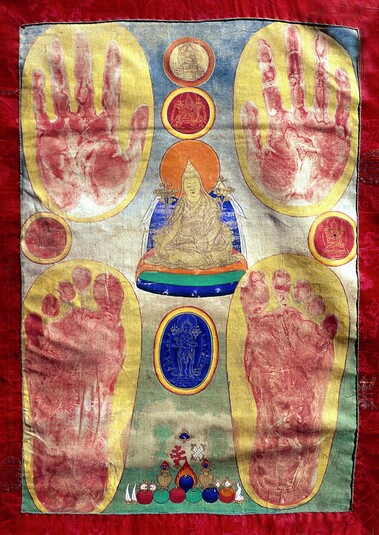
Item: Teacher (Lama) - Jamyang Kyentse Wangpo
| Origin Location | Eastern Tibet |
|---|---|
| Date Range | 1800 - 1899 |
| Lineages | Nyingma, Sakya and Buddhist |
| Material | Ground Mineral Pigment on Cotton |
| Collection | Private |
Jamyang Khyentse Wangpo (1820-1892) at the center accompanied by hand and foot prints. See two other similar compositions. (See Jamyang Khyentse Wanpo Main Page). (See HAR #15476).
The Tibetan custom of having drawings done based on the physical outline of a teachers feet (and later - hands) appears to be an oral instruction coming down from Gampopa Sonam Rinchen. The most famous early text describing this practice was written by Pagmodrupa Dorje Gyalpo - a direct student of Gampopa. A number of early paintings are known that depict the feet of Drigung and Taglung teachers. (See Footprints & Handprints Main Page).
At the center is Jamyang Khyentse Wangpo with the right hand extended across the knee, palm up, holding the stem of a flower blossom supporting a sword and book - emblems of wisdom and Sutra learning. The left hand is in the lap cradling a vase while holding a stem of a flower blossom rising above the left shoulder supporting a vajra and bell - emblems Tantric learning. Attired in the garb of a fully ordained monk, he wears a pandita hat with three rings representing the accomplishment of having learned all of the three components of the Buddhist Tripitaka.
At the top center is Manjushri holding a sword upraised in the right hand. Below the central figure, within a blue oblong sphere is Sarasvati holding the stems of two utpala flowers crossed at the heart supporting a sword and book.
At the viewers middle left side, in a red sphere, the figure appears to be Choggyur Lingpa. On the right side, again in a red sphere, it appears to be Jamgon Kongtrul.
Jeff Watt 2-2011
Collection: Private 4, Painting (Masterwork Galleries)
Collection: Private 4 (Painting)
Teacher: Jamyang Khyentse Wangpo Main Page
Subject: Three Manjushri Embodiments
Collection: Private 4 (Teachers)
Collection: Private 4 (Painting 19th Century)
Subject: Footprints & Handprints Main Page
Subject: Footprints (Lamas)
Subject: Footprints & Handprints (Nyingma)
Subject: Footprints & Handprints (Both)
